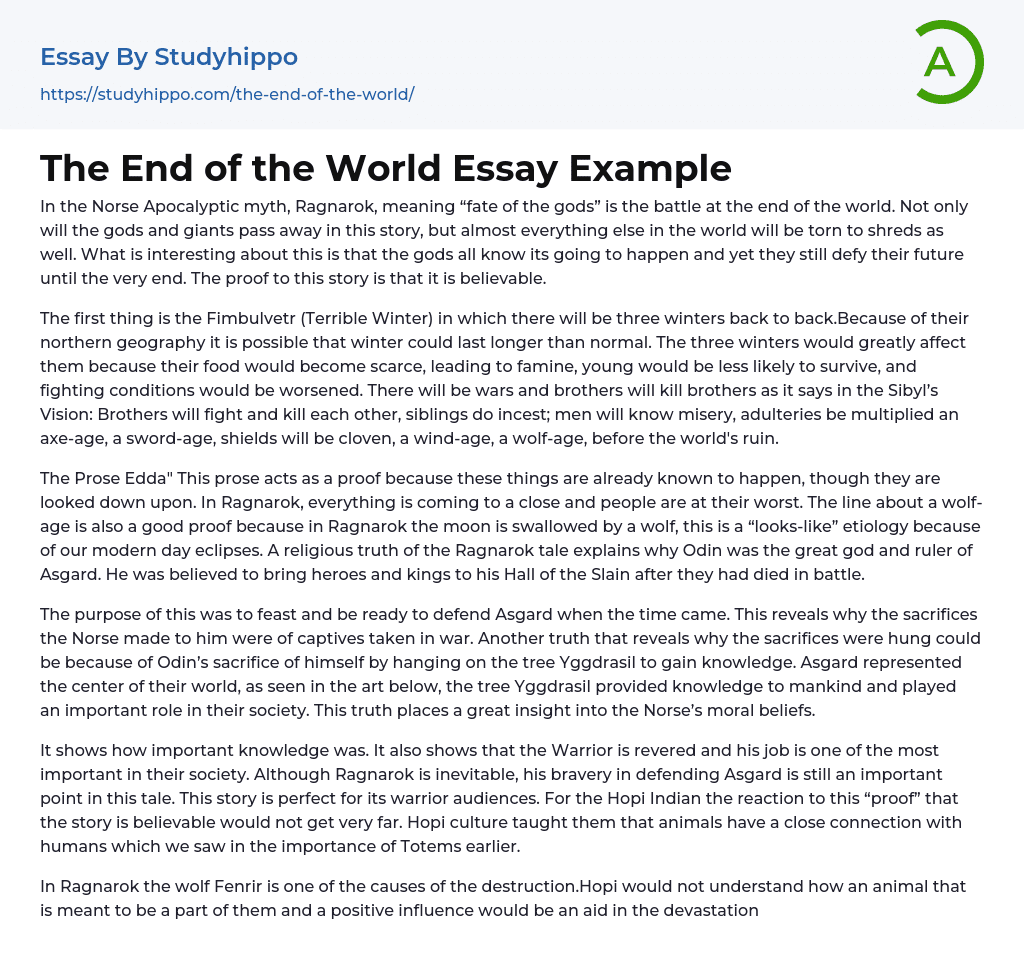
In the Norse Apocalyptic myth, Ragnarok, meaning “fate of the gods” is the battle at the end of the world. Not only will the gods and giants pass away in this story, but almost everything else in the world will be torn to shreds as well. What is interesting about this is that the gods all know its going to happen and yet they still defy their future until the very end. The proof to this story is that it is believable.
The first thing is the Fimbulvetr (Terrible Winter) in which there will be three winters back to back.Because of their northern geography it is possible that winter could last longer than normal. The three winters would greatly affect them because their food would become scarce, leading to famine, young would be less likely to survive, and fightin
...g conditions would be worsened. There will be wars and brothers will kill brothers as it says in the Sibyl’s Vision: Brothers will fight and kill each other, siblings do incest; men will know misery, adulteries be multiplied an axe-age, a sword-age, shields will be cloven, a wind-age, a wolf-age, before the world's ruin.
The Prose Edda" This prose acts as a proof because these things are already known to happen, though they are looked down upon. In Ragnarok, everything is coming to a close and people are at their worst. The line about a wolf-age is also a good proof because in Ragnarok the moon is swallowed by a wolf, this is a “looks-like” etiology because of our modern day eclipses. A religious truth of the Ragnarok tale explains why Odin was the great god and
ruler of Asgard. He was believed to bring heroes and kings to his Hall of the Slain after they had died in battle.
The purpose of this was to feast and be ready to defend Asgard when the time came. This reveals why the sacrifices the Norse made to him were of captives taken in war. Another truth that reveals why the sacrifices were hung could be because of Odin’s sacrifice of himself by hanging on the tree Yggdrasil to gain knowledge. Asgard represented the center of their world, as seen in the art below, the tree Yggdrasil provided knowledge to mankind and played an important role in their society. This truth places a great insight into the Norse’s moral beliefs.
It shows how important knowledge was. It also shows that the Warrior is revered and his job is one of the most important in their society. Although Ragnarok is inevitable, his bravery in defending Asgard is still an important point in this tale. This story is perfect for its warrior audiences. For the Hopi Indian the reaction to this “proof” that the story is believable would not get very far. Hopi culture taught them that animals have a close connection with humans which we saw in the importance of Totems earlier.
In Ragnarok the wolf Fenrir is one of the causes of the destruction.Hopi would not understand how an animal that is meant to be a part of them and a positive influence would be an aid in the devastation of their people. In fact, it would most likely be very upsetting to them. Hopi’s also didn’t place the same kind of emphasis on warriors as
the Norse did.
The Hopi’s value system was much more centered on peace and maintaining a good spirit in order to go to the land of the One Heart. They had a much more egalitarian view, in that they would’ve taught that things should be shared equally instead of warring with each other.Because of their myth about Spider Women the idea of Odin leading the Norse would go against their matrilineal belief system. The “truth” of the Ragnarok myth wouldn’t make sense to the Hopi because their apocalypse myth revolves around the destruction of people around them while they remained intact. In Ragnarok everyone knows they are doomed yet fights to their last breath. Hopi audiences’ reaction to the sacrifices and their reasoning behind it would also be lost.
Therefore, the Hopi Indians wouldn’t be able to relate to the Norse Mythology
- Boo Radley essays
- Genesis essays
- Richard iii essays
- Alice in Wonderland essays
- On the road essays
- Ozymandias essays
- The Nightingale essays
- Holden Caulfield essays
- Animal Farm essays
- 1984 essays
- A Hanging essays
- Shooting An Elephant essays
- A Tale Of Two Cities essays
- Adventures Of Huckleberry Finn essays
- Arthur Conan Doyle essays
- Brave New World essays
- Characters In Hamlet essays
- Characters In Romeo And Juliet essays
- Desdemona essays
- Diary Of A Wimpy Kid essays
- First-Person Narrative essays
- Frankenstein essays
- Heart Of Darkness essays
- Jane Eyre essays
- Jay Gatsby essays
- King Duncan essays
- Librarian essays
- Little Red Riding Hood essays
- Lord Of The Flies essays
- Silas Marner essays
- The Cask Of Amontillado essays
- The Catcher In The Rye essays
- The Crucible essays
- The Handmaid's Tale essays
- The Reader essays
- Virgil essays
- Wuthering Heights essays
- Candide essays
- Castle essays
- J. D. Salinger essays
- Ulysses essays
- Ethan Frome essays
- In Cold Blood essays
- Outliers essays
- Tuesdays With Morrie essays
- The Art of War essays
- Wife of Bath essays
- Huckleberry Finn essays
- The Lady With The Dog essays
- Great Expectations essays



